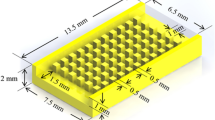Abstract
A new effectiveness-NTU method is developed for a special type of heat exchangers. in which the fluid of a passage is in simultaneous thermal contact with two separate fluids flowing in the opposite direction. An extensive amount of numerical simulations are carried out by an iterative method for wide ranges of dimensionless parameters such as ratios of capacity rates, NTU’s, or a dimensionless inlet temperature. The large body of resulting data are then effectively reduced to a small number of simple equations and graphs by introducing a new effectiveness, ε. ε is defined as the ratio of actual heat transfer to the maximum heat transfer obtained when the NTU’s become very large while the ratio of two NTU’s is kept constant. The developed method is readily applicable to the cycle analysis and design, in the same way as the ε-NTU method for the usual double-passage heat exchangers.
Similar content being viewed by others
Abbreviations
- A :
-
Heat exchange area, m2
- C :
-
Flow-stream capacity rate, kW/K=(mass flow rate)x(specific heat at constant pressure)
- g :
-
Coefficient of functionG(X), dimensionless
- G :
-
Function ofX, defined by Eq. (21), dimensionless
- L :
-
Heat exchanger length, m
- N :
-
Ratio of two NTU’s, defined by Eq. (18)
- NTU :
-
Number of transfer unit, dimensionless
- q :
-
Heat transfer rate, kW
- T :
-
Fluid temperature, K
- U :
-
Overall heat transfer coefficient, kW/m2-K
- x :
-
Axial flow coordinate, m
- X :
-
Parameter related to fluid capacity rates, defined by Eq. (14)
- ε:
-
Heat exchanger effectiveness, dimensionless
- θ:
-
Dimensionless temperature
- ξ:
-
Dimensionless axial flow coordinate
- 1:
-
Hot fluid with higher inlet temperature
- 2:
-
Hot fluid with lower inlet temperature
- 3:
-
Cold fluid
- max:
-
Maximum value
- min:
-
Minimum value
References
Aoki, K., Doi, Y., Kondo, Y., Shintomi, T., Makida, Y., Hashimoto, O., Kitami, T., Miyachi, T., Nagae, T. and Sekimoto, M., 1992, “Performance of Cryogenic Systems for a Large Superconducting Spectrometer Magnet,” Advances in Cryogenic Engineering, Vol. 37, Part A, pp. 691–698.
Asakura, H., Kato, D., Saji, N. and Ohya, H., 1992, “80 K Centrifugal Compressor for Helium Refrigeration System,” Advances in Cryogenic Engineering, Vol. 37, Part B, pp. 787–794.
Brindza, P., Chronis, W. and Rode, C., 1988, “CEBAF’s Cryogenic System,” Advances in Cryogenic Engineering, Vol. 33, pp. 623–630.
Chang, H.-M., Lee, T. I., Baik, J.H. and Cho, Y.-H., 1993, “A Study on the Cooling Systems of Superconducting Magnets for Medical Imaging,” KOSEF Final Report No. 913-0901-013-2.
Clausen, J., Patzelt, A., Stephan, A. and Wanner, M., 1990, “The Linde-Turborefrigerator for MT-Tomographs,” Advances in Cryogenic Engineering, Vol. 35, Part B, pp. 949–955.
Dauvergne, J.P., Firth, M., Juillerat, A., Lebrun, P. and Rieubland, J.M., 1990, “Helium Cryogenics at the LEP Experimental Areas,” Advances in Cryogenic Engineering, Vol. 35, Part B, pp. 901–900.
Ganni, V., Moor, R. and Winn, P., 1986, “Capacity Upgrade of the Exell Helium Liquefier Plant by the Adding a Wet Engine,” Advances in Cryogenic Engineering, Vol. 31, pp. 699–707.
Kays, W.M. and London, A.L., 1984, “Compact Heat Exchangers,” 3rd ed., McGraw-Hill, New York, pp. 19–24.
Slack, D.S., Nelson, R.L. and Chronis, W.C., 1986, “Cryogenic Systems for the Mirror Fusion Test Facility,” Advances in Cryogenic Engineering, Vol. 31, pp. 583–594.
Timmerhaus, K.D. and Flynn, T.M., 1989, “Cryogenic Process Engineering,” Plenum Press, New York, pp. 261–266.
Tsuchiya, K., Ohuchi, N., Terashima, A. and Shinkai, K., 1990, “Cryogenic System of the Superconducting Insertion Quadrupole Magnets for Tristan Main Ring,” Advances in Cryogenic Engineering, Vol. 35, Part B, PP. 941–948.
Tsuchiya, K., Ohuchi, N., Morita, Y., Sugahara, R., Kabe, A., Endo, K., Kawamura, S. and Matsumoto, K., 1992, “Helium Cryogenic Systems for the Superconducting. Insertion Quadrupole Magnets of the Tristan Storage Ring,” Advances in Cryogenic Engineering, Vol. 37, Part A, pp. 667–674.
Yamamoto, J., Mito, T., Motojima, O., Asami, T., Ebisu, H. and Otani, T., 1990, “Feasibility Study of Cooling System of New Superconducting Large Helium Fusion Reactor,” Advances in Cryogenic Engineering, Vol. 35, Part B, pp. 967–974.
Yanagi, H., Yaguchi, H., Yabana, T., Fujima, K., Ino, N. and Yasuda, A., 1992, “The Planning of a Low Temperature Purifier for Super-GM Helium Refrigeration Plant,” Advances in Cryogenic Engineering, Vol. 37, Part A, pp. 739–746.
Ziegler, B. and Quack, H., 1992, “Helium Refrigeration at 40 Percent Efficiency?,” Advances in Cryogenic Engineering, Vol. 34, Part A, pp. 645–951.
Author information
Authors and Affiliations
Rights and permissions
About this article
Cite this article
Cho, YH., Chang, HM. An effectiveness-NTU method for triple-passage counterflow heat exchangers. KSME Journal 7, 282–289 (1993). https://doi.org/10.1007/BF02970972
Received:
Issue Date:
DOI: https://doi.org/10.1007/BF02970972




